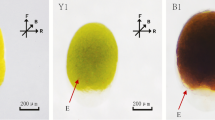Abstract
Somatolactin (SL) plays an essential role in body-color regulation in medaka and is encoded by the color interfere (ci) locus. The ci mutant fish possess constitutively increased numbers of leucophores and a concomitant decrease in visible xanthophores. However, the mechanism of action of SL on these cell types, and the role of SL in body-color regulation in other species, is unknown. In this study, we verified an SL–xanthophore relationship in ci mutant fish using the leucophore free (lf) gene. Histological observation of lf larvae indicated that these mutants do not possess differentiated leucophores. The ci–lf double mutant, whose genotype was confirmed using DNA markers, lacked leucophores; however, the number of xanthophores remained low, demonstrating that leucophores are not necessary for mediating SL signaling to xanthophores. This finding suggests a conserved function for SL in xanthophore regulation across species, rather than the evolution of a medaka-specific and leucophore-dependent role of SL in body-color regulation. Our results also demonstrate that the lf gene has an indispensable role in leucophore development epistatic to SL signaling. The lf gene has not been cloned. The high-resolution recombination map surrounding the lf locus constructed in this study, together with medaka whole genome sequences that will be released soon, will allow the rapid cloning of the lf gene by forward genetic approaches.



Similar content being viewed by others
References
Bagnara JT (1998) Comparative anatomy and physiology of pigment cells in nonmammalian tissues. In: Nordlund JJ, Boissy RE, Hearing VJ, King RA, Ortonne JP (eds) The pigmentary system: physiology and pathophysiology. Oxford University Press, New York, pp 9–40
Bennett DC, Lamoreux ML (2003) The color loci of mice — a genetic century. Pigment Cell Res 16:333–344
Fukamachi S, Shimada A, Shima A (2001) Mutations in the gene encoding B, a novel transporter protein, reduce melanin content in medaka. Nat Genet 28:381–385
Fukamachi S, Sugimoto M, Mitani H, Shima A (2004a) Somatolactin selectively regulates proliferation and morphogenesis of neural-crest derived pigment cells in medaka. Proc Natl Acad Sci USA 101:10661–10666
Fukamachi S, Asakawa S, Wakamatsu Y, Shimizu N, Mitani H, Shima A (2004b) Conserved function of medaka pink-eyed dilution in melanin synthesis and its divergent transcriptional regulation in gonads among vertebrates. Genetics 168:1519–1527
Fukamachi S, Yada T, Mitani H (2005) Medaka receptors for somatolactin and growth hormone: phylogenetic paradox among fish growth hormone receptors. Genetics (in press)
Kakizawa S, Kaneko T, Hasegawa S, Hirano T (1995) Effects of feeding, fasting, background adaptation, acute stress, and exhaustive exercise on the plasma somatolactin concentrations in rainbow trout. Gen Comp Endocrinol 98:137–146
Kaneko T, Kakizawa S, Yada T (1993) Pituitary of ‘cobalt’ variant of the rainbow trout separated from the hypothalamus lacks most pars intermedial and neurohypophysial tissue. Gen Comp Endocrinol 92:31–40
Kelsh RN, Inoue C, Momoi A, Kondoh H, Furutani-Seiki M, Ozato K, Wakamatsu Y (2004) The Tomita collection of medaka pigmentation mutants as a resource for understanding neural crest cell development. Mech Dev 121:841–859
Lamoreux ML, Kelsh RN, Wakamatsu Y, Ozato K (2005) Pigment pattern formation in the medaka embryo. Pigment fCell Res 18:64–73
Naruse K, Tanaka M, Mita K, Shima A, Postlethwait J, Mitani H (2004) A medaka gene map: the trace of ancestral vertebrate proto-chromosomes revealed by comparative gene mapping. Genome Res 14:820–828
Parichy DM (2003) Pigment patterns: fish in stripes and spots. Curr Biol 13:947–950
Tomita H (1992) Studies on the mutant of the medaka, lf. Fish Biol J Medaka 4:45–47
Wada H, Shimada A, Fukamachi S, Naruse K, Shima A (1998) Sex-linked inheritance of the lf locus in the medaka fish (Oryzias latipes). Zoolog Sci 15:123–126
Zhu Y, Thomas P (1995) Red drum somatolactin: development of a homologous radioimmunoassay and plasma levels after exposure to stressors or various backgrounds. Gen Comp Endocrinol 99:275–288
Acknowledgements
The authors thank K. Naruse and E. Nagao of the University of Tokyo for providing marker information around the lf locus. We also thank K. Yori and T. Yamashita for advice on histological sectioning and fish care, respectively. S.F. is a Research Fellow of the Japan Society for the Promotion of Science (JSPS; #17-10821).
Author information
Authors and Affiliations
Corresponding author
Additional information
Communicated by M Hammerschmidt
Rights and permissions
About this article
Cite this article
Fukamachi, S., Wakamatsu, Y. & Mitani, H. Medaka double mutants for color interfere and leucophore free: characterization of the xanthophore–somatolactin relationship using the leucophore free gene. Dev Genes Evol 216, 152–157 (2006). https://doi.org/10.1007/s00427-005-0040-9
Received:
Accepted:
Published:
Issue Date:
DOI: https://doi.org/10.1007/s00427-005-0040-9




